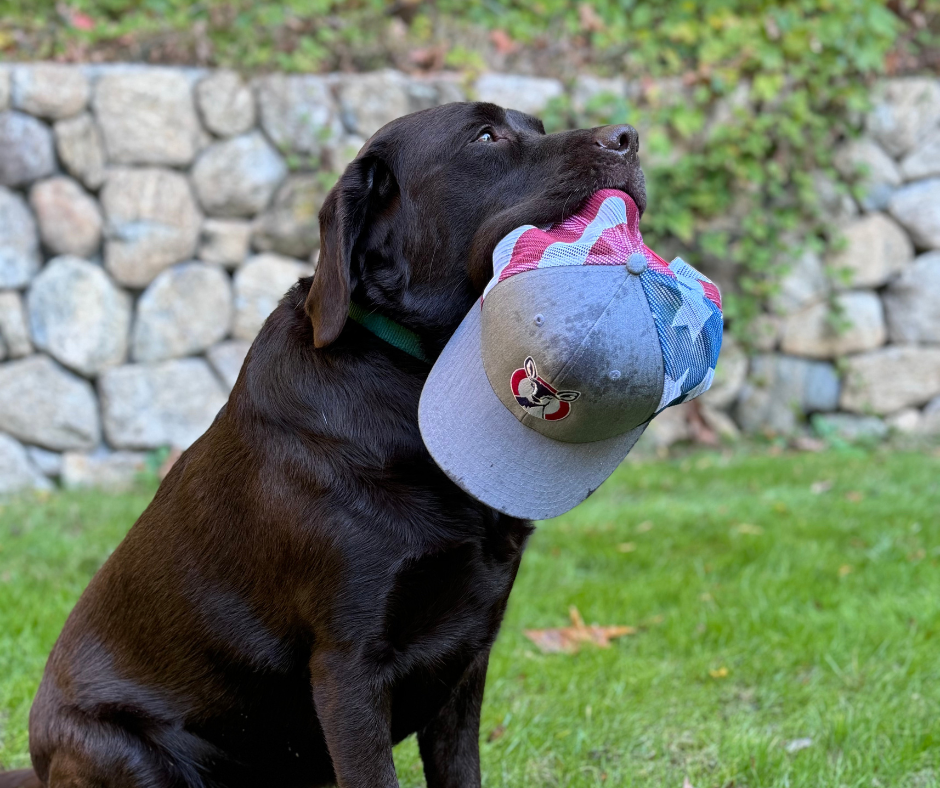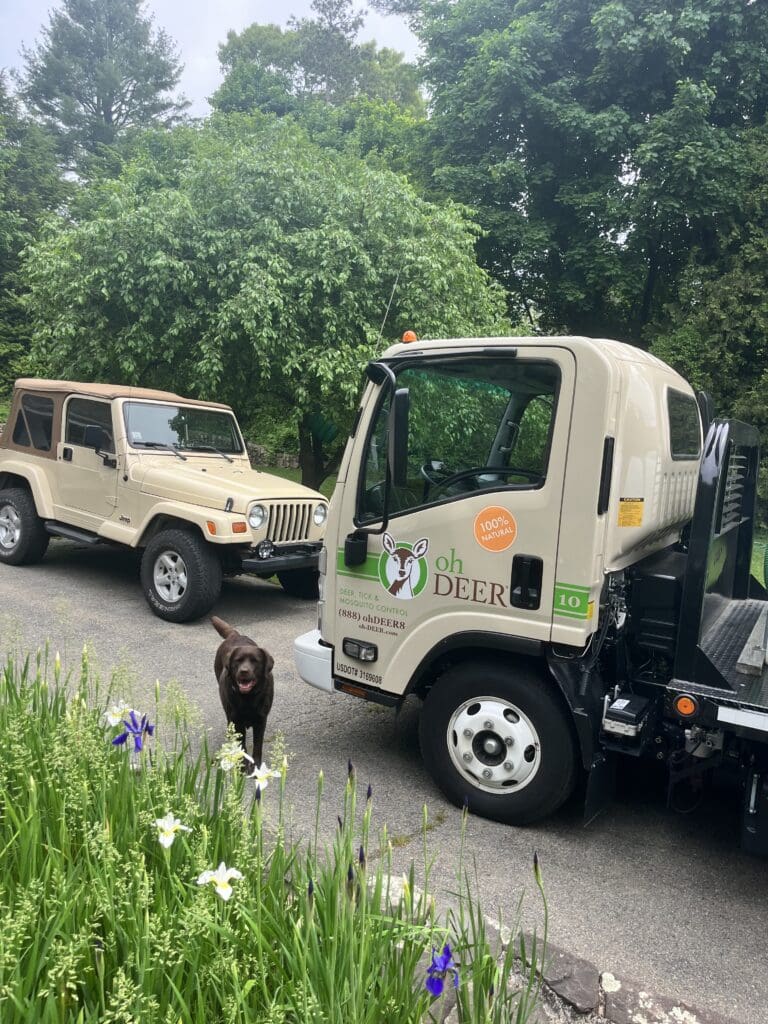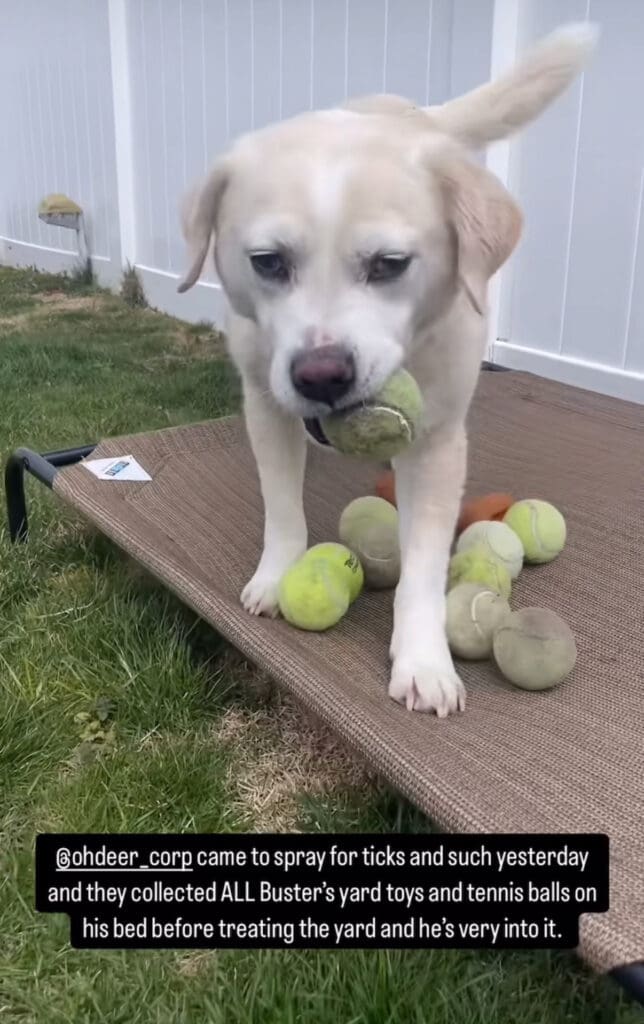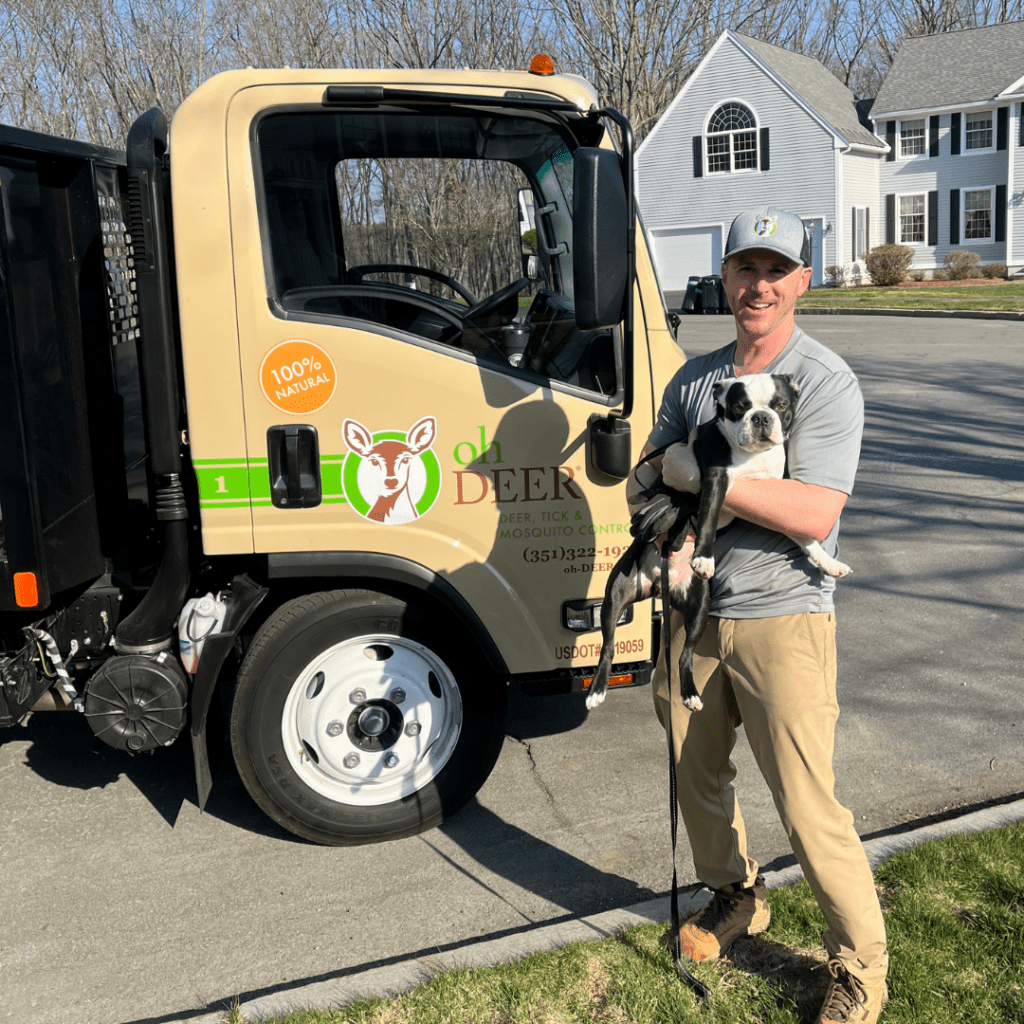

As dog lovers, we would do anything to keep our four-legged family members safe! From choosing the best food and toys, to bringing them to regular vet visits, we prioritize their health and happiness. But one question many pet owners overlook is critical: Is pest control safe for dogs? The chemical insecticides and pesticides used in many pest control products may promise a “bug-free yard”, but they can also put your dog’s safety in danger.
At ohDEER, we believe that pest control shouldn’t come at the expense of your pup’s well-being. That’s why we offer All-Natural solutions that are safe for your entire family, dogs included! But before we get to that, let’s talk about why chemical pesticides are so dangerous for pets, particularly dogs.


If you’re a pet owner, your top priority is likely keeping your furry family members safe. You dog-proof your home by tucking chocolate out of reach, securing trash cans, and keeping the toilet lid down. But what about your yard?
If you use traditional pest control, you may be unknowingly exposing your pets to harmful pesticides. The chemicals used to kill ticks, mosquitoes, and other pests can also affect dog, especially if they walk or roll in treated areas, or lick their paws after coming inside.
So, are pesticides safe for pets? Here’s what every pet owner should know.
Many conventional pesticides contain toxic chemicals that are harmful to dogs. Common ingredients like pyrethroids, organophosphates, and DEET can cause poisoning in pets through skin contact, ingestion, or inhalation.
Even if your traditional pest control provider says it’s “pet-safe” after drying, residue can linger on your grass, patio furniture, or pet’s toys, and be transferred to their paws, fur, or mouth. If there is an evacuation period where you need to keep your dog out of your yard until the solution dries, that is a sign there are dangerous chemicals involved.
Dogs can come into contact with pesticides in more ways than you might think. These include:
Pets exposed to chemical pesticides may show signs of toxicity within minutes or days, depending on the chemical and level of exposure. Symptoms that may be warning signs of pesticide poisoning:
If you notice any of these symptoms, don’t wait! Contact your veterinarian immediately, and call the Pet Poison Helpline (855) 764-7661 or the ASPCA Animal Poison Control Center (888) 426-4435.

If you suspect your dog has come into contact with a pesticide, you should seek veterinary care immediately. Bring any product packaging you have, it can help your vet determine what kind of toxin they’re dealing with.
Your vet will perform:
Often, vets will begin treatment based on the symptoms and known exposure, even before test results come back. Each case of pesticide poisoning is unique, and treatment decisions depend on a combination of exposure history and clinical signs.
(Source: PetMD)
Treatment varies depending on what your dog was exposed to and how severe their symptoms are. Common veterinary interventions include:
1. Removal of Residue: If the exposure was through the skin or fur, your vet may bathe your dog using special shampoos or detergents to remove any remaining chemicals.
2. Emesis (Induced Vomiting): If your dog swallowed a pesticide, your vet may induce vomiting unless it was a hydrocarbon (like motor oil-based products), which can cause aspiration and worsen the situation.
3. Activated Charcoal: To prevent further absorption of the poison, vets may administer activated charcoal after vomiting has been induced.
4. Medications: Depending on the compound, your vet may give drugs such as: Atropine, which helps stabilize the nervous system, Muscle relaxants or anti-seizure medications in more severe cases.
5. IV Fluids & Oxygen Therapy: If your dog is dehydrated or experiencing breathing difficulty, IV fluids and oxygen may be necessary.
Every case is different and recovery depends on the type of pesticide, how much was ingested, and how quickly treatment began. Your vet may want to monitor your dog for at least 24 hours, even after treatment begins. At-home recovery instructions will vary, and it’s important to follow your vet’s guidance and attend any recommended follow-up appointments.
(Source: PetMD)
According to the ASPCA Animal Poison Control Center, insecticide ingestion ranks among the top 10 most common toxicities for pets. These toxic substances, designed to kill insects, often end up harming dogs unintentionally.
Insecticides are used in a wide variety of lawn and garden treatments. The Environmental Protection Agency (EPA) recognizes 20 insecticide classes with nearly 400 chemical compounds and more than 17,000 products on the market. With numbers like that, it’s no surprise that accidental exposure to dogs is so common.
Many insecticides work by attacking the nervous systems of insects. Unfortunately, these compounds don’t distinguish between bugs and beloved pets.
Two of the most common classes of insecticides are organophosphates and carbamates. These chemicals block an enzyme called acetylcholinesterase, which causes nerve overstimulation. In dogs, this can lead to severe symptoms like muscle tremors, seizures, paralysis or even death.
Another widely used class is pyrethrins and pyrethroids, which similarly overexcite the nervous system. These are commonly found in over-the-counter sprays, foggers, and even some pet flea and tick products. While pyrethrins are natural and derived from chrysanthemum flowers, pyrethroids are synthetic and much more potent, especially for small animals.
The Centers for Disease Control and Prevention (CDC) reports that organophosphates are still some of the most widely used insecticides today, making them a major cause of accidental poisoning in pets.
If your dog is exposed to a chemical pesticide, symptoms may appear within minutes to hours. According to PetMD, dogs exposed to insecticides may experience symptoms such as:
If you notice any of these symptoms, don’t wait! Contact your veterinarian immediately, and call the Pet Poison Helpline (855) 764-7661 or the ASPCA Animal Poison Control Center (888) 426-4435.
At ohDEER, we believe in protecting your pets, not putting them at risk. Our All-Natural Deer, Tick and Mosquito Control services are 100% safe for dogs, kids, and the environment.
In fact, your dog can play in the yard while we spray, no need to keep them inside for hours or worry about their paws picking up toxic residue. There is no evacuation period for our products. You can play outside during and after the service is completed. You do not have to take toys out of the yard before spraying and your kids and pets can safely enjoy your yard while we spray! We want you to enjoy more time outside so there are no wait times with our chemical-free solutions! We are applying about 40-50 Gallons of product on an average property so you may pick up a little dampness, but this will dry in about 30 minutes.

We use proprietary blends of essential oils and other naturally derived ingredients that are effective at repelling pests without harming your furry family members. Whether you’re dealing with mosquitos and ticks ruining the fun in your outdoor spaces or deer munching your plants, we’ve got a safe and effective solution.


When it comes to pest control, don’t take chances. Your dog is a beloved member of your family, and they deserve to be protected from the hidden dangers lurking in conventional pesticide treatments.
Make the safe, natural, and effective choice with ohDEER. Your pup will thank you with tail wags, kisses, zoomies, and plenty of time outside.
Call your nearest ohDEER today and discover how ohDEER can help you enjoy more time outside, safely! Trusted by families across Massachusetts, Rhode Island, Virginia, New Hampshire, Maryland, Martha’s Vineyard, Nantucket, Missouri and Ohio.



Whether you hire a pest control company or do it yourself, read the label. Ask questions. Look up ingredients. Don’t assume all “green” pest control is safe, many companies use reduced-risk pesticides that still carry risks to pets. When in doubt, vet your pest control provider and choose one that is committed to All-Natural solutions and transparency about what they’re spraying around your home.
ohDEER is looking for franchise owners to bring All-Natural Tick & Mosquito Control to their community and make a difference by protecting local families and pets.
Check out our franchising site for more information about the ohDEER franchise ownership opportunity. Also, learn more about pest control trends.